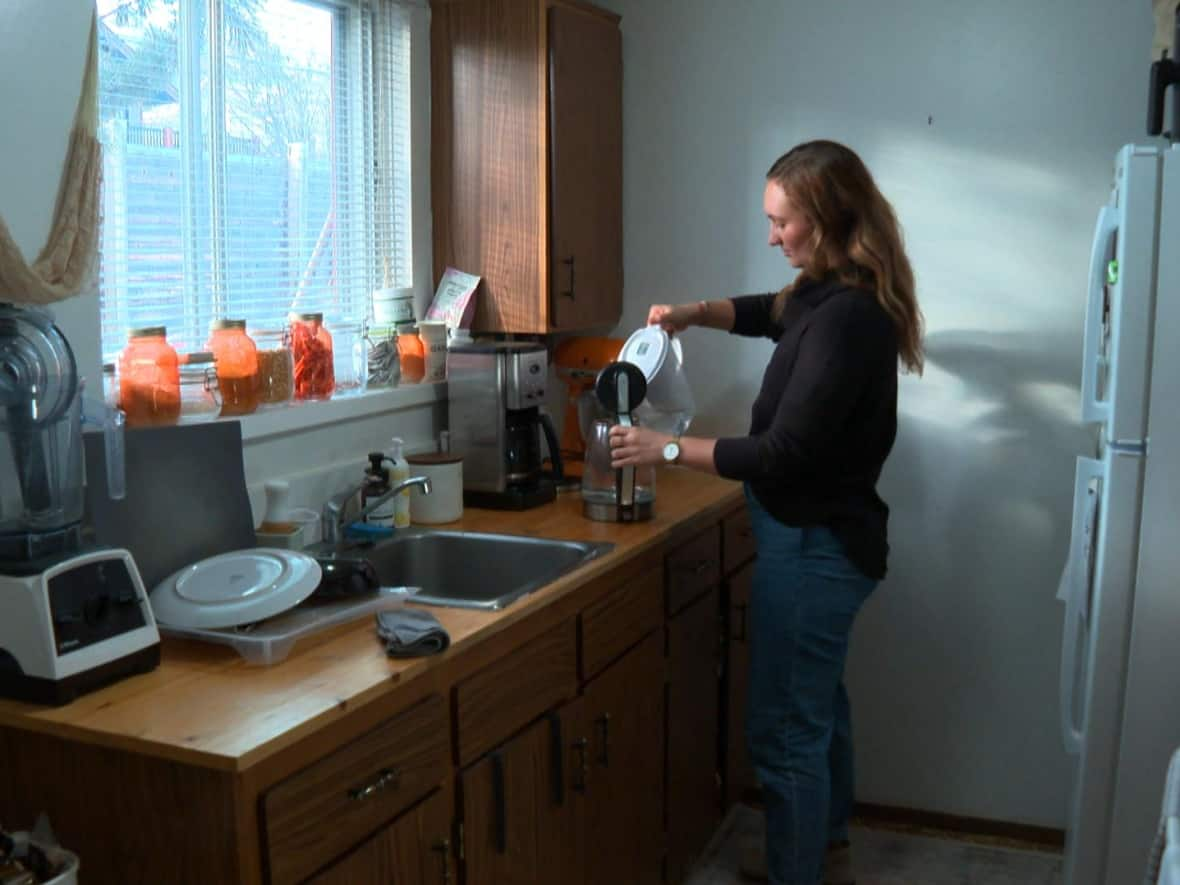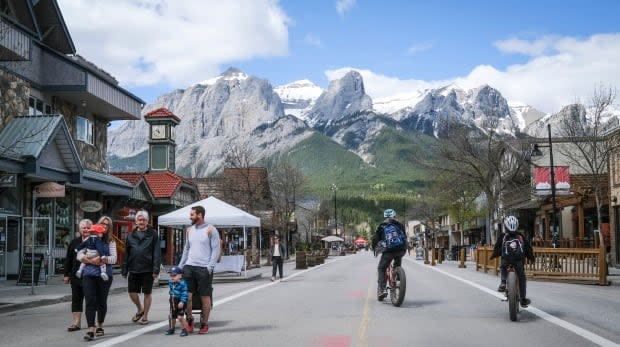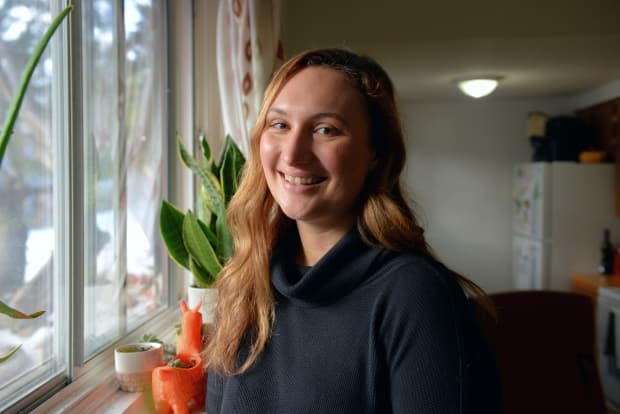Canmore's cost of living is the highest in Alberta. So how do people make it work?

Sabina Litherland, like many in the Bow Valley, has a second job on top of the full-time work she does at the Banff Centre.
For her, it's an extra 15 hours a week as a server — in hopes the tourist town tips are flowing, and that extra cash will help when rent and bills are due.
This mountain town 100 kilometres west of Calgary has always had a reputation for being an expensive place to settle. But every year, foreign workers on visas and Canadians flock to the picturesque place and make it work — even in a time of rising costs.
"I just have faith in my ability to kind of make it work because I've made it work so far," Litherland said. "I just kind of have faith that whatever happens, you know, I will keep the roof over my head.
According to the Bow Valley Job Resource Centre, average wages sit at $20.75 per hour — a considerable gap from the $32.75 per hour cost of living the Alberta Living Wage Network suggests Canmorites should earn to live comfortably.
The Canmore Young Adult Network (CYAN) connects young adults in the Bow Valley with affordable by-donation events and online resources on things like housing and food security.
In annual surveys, advertised through social media, CYAN director of operations Nicole Eplett said they know a majority of young people want to call Canmore home long-term but feel it's out of reach.
"It's not feasible to stay in Canmore because of other various struggles within the Bow Valley from financial stability to the housing market," Eplett said.
The things making life difficult for young people in the Bow Valley? Eplett says a high cost of living is at the top of the list, along with a lack of affordable housing, few career advancements and social isolation.

"It is difficult when you love a community and you're not able to really grow in that community," said Lisa Brown.
Brown started working as the manager of community social development for the Town of Canmore in 2015. She's watched costs in the mountain town rise.
When she talks about that living wage figure, she points out it isn't meant to dictate how much an individual should be paid. Rather, it is a way to reflect what the cost of living is for an average household in the community.
"Canmore is quite, quite expensive, but [a living wage] doesn't look at all the other community resources," she said.
These are grassroots initiatives like gear swaps, food swaps and weekly free community meals.
Some businesses provide staff accommodation, a free meal for workers or health-care coverage.

The town's investments in affordable housing and services like free transit, and affordable summer camps, Brown said, all make a difference.
But in talks with the provincial government, she hopes the town can leverage concepts or ideas that would help Canmore keep affordability in reach.
One example she points to is the northern living allowance, a concept the town could use in discussions with the province.
"You know, in Canmore, a living wage family pays more taxes and earns fewer benefits than a living wage family anywhere else in Alberta," Brown said.
Affordable grocery trip becomes a grocery trek
According to a 2017 Living Wage report, standard food items in Canmore cost five per cent more than anywhere else in Alberta.
Many, Eplett said, hit up Walmart, Costco or No Frills in Cochrane or Calgary. Despite the 70- to 100-kilometre drive, it's still worth the trip.
For veggies, Eplett said she finds savings by buying a $30 Good Food Box. For big-ticket items, she leaves the Bow Valley.
A religious budgeter, Litherland saw her monthly grocery bill double between January 2022 and October.
As a vegan, Litherland's meatless grocery hauls aren't as expensive. To save more, she's decided to order groceries from Spud.ca instead of driving to the city. So far, she finds it's cheaper than in town and helps her cut down on impulse buys.

Her biggest worry isn't that grocery bill but the thought of the rent for her studio apartment going up. Living alone is one of the choices she's made after moving out of staff accommodation, and a choice she hopes she can keep up with, financially.
"I have a friend who recently gave up their place to kind of move in with people because the rent was increased," Litherland said. "When I look at some of my friends who are paying not that much less than me and they're living with four or five other people … it makes sense to continue living alone."
Canmore Community Housing tracks the rental market closely. Theresa Newland said rents have consistently gone up in the town. Between 2020 and 2022, a two-bedroom suite has gone up in price from an average of $2,010 to $2,735.
"I don't know if there's ever going to be a ceiling to that increase," Newland said.
Cost of rentals and homes a problem
The not-for-profit provides affordable rental homes and accessible home ownership for those working in the town. Right now, it manages 118 purpose-built rental units that are rented out at a minimum of 10 per cent below the market rate.
A wait list of about 89 people is higher than the typical 60 to 75 that Newland was tracking pre-pandemic.
The average wait is about seven months across all unit types. For studio apartments, Newland said the wait is more than a year.
"We have a healthy wait list," Newland said. "As prices increase, it's not only prices and housing that have increased.… I think people are just looking for more affordable ways to save money."
This year, on the homeownership side, Canmore Community Housing made changes to its eligibility criteria. Last year, the gross household income cap to qualify was $147,423. Effective Jan. 1, 2023, that's now bumped up to a cap of $250,000 gross household income.
The idea here is to capture more people living in town and struggling to own a home.
Putting life on hold, or holding back on milestones
When COVID hit, Litherland was able to move home to Ontario and live rent-free under her parent's roof — a time she was thankful for in terms of her ability to save up. By the time pandemic restrictions eased, she was able to move back to the Bow Valley with a bit of a nest egg.
That cash didn't take her far.
"Do I wish I had more of a nest egg? Absolutely," Litherland said. "I look at a lot of my peers who I went to university with who are working in similar positions in the arts back in Toronto. There is a perception that they do have more."
Eplett said that for many there isn't much opportunity for growth long-term in Canmore. So staying in the mountain town holds them back from moving up that ladder, and earning enough to buy a home.
She's had friends move away because they just can't find the right job in the community, or because of the high cost of living.
"I definitely have given up a few things in order to be here," said Eplett, who has lived in Canmore for nine years. "Financially, long term it just extended my big goals. So buying a house, you know, building a career or things like that."

Litherland always circles back to the core reason Canmore and the Bow Valley are home: the experiences she's had. Camping trips, perfect bluebird days on the ski hill, travel, hikes and time spent reading a good book by the river.
"Last year, did I spend more than I earned? Unfortunately," Litherland said. "But those memories last longer than the money, I think."
When she thinks about a future, Canmore is something she'd hope remains on the horizon. But a reality check hits when that dream meets the local real estate listings. According to Royal LePage, in 2022, the median price for a single-family home was about $1.5 million and a condo $663,400.
"You know, two years ago or so, I was kind of saving with the goal of purchasing," Litherland said. "Looking at the real estate prices, that dream has kind of been dashed."


